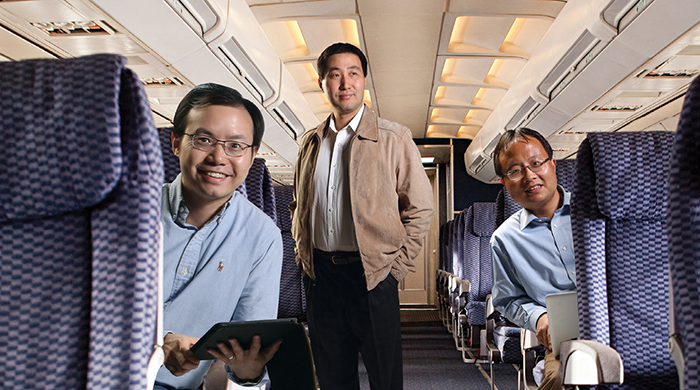High-flying Wi-Fi

In the next five years, Dr. Liang Dong envisions a day when airline passengers in flight will be able to make a call from their cell phones to someone on the ground or Skype during an international flight. As part of the communication technology he and a team of researchers are developing, he sees flights becoming safer and technology becoming more widely accessible. "I'm the type of person who wants to make good use of time. I travel a lot," said Dong, associate professor of electrical and computer engineering, in Baylor's School of Engineering and Computer Science.
He and Drs. Jonathan Hu and Yang Li, assistant professors of electrical and computer engineering, are developing a high definition wireless in-flight entertainment and communications system for VIP and military flights. He says that one day the growing technology will make its way to the mainstream consumer market. The system mirrors a wireless home network.
In order for each passenger to stream high definition video on their personal devices, the technology requires an extremely high data rate. "In the near future, passengers on board should be able to...update their social status and watch Netflix using their own wireless devices, just as what they do in their own houses," said Li. "This seamless transition from land to air will enable our dream of communicating anywhere, anytime," he added.
"Unaccompanied minors on the airplane will be able to interact with their family members on the ground," said Hu. In case of a medical emergency, "flight personnel can have video diagnostics with doctors on the ground."
Their lab hallway in the Baylor Research and Innovation Collaborative facility, also known as the BRIC, simulates the length of a plane and is used to test whether video can be streamed clearly in different parts of a plane. Waco's L-3 group has provided the researchers funding over the last two years to further the work. L-3 provides a range of communication and electronic systems and products used on military and commercial platforms. They also focus on national security solutions.
With terrorism and missing flights in international headlines, Dong said the technology has implications for passenger safety in three areas.
The researchers are building different levels of security so that those with varying levels of authorization could have access to the network. Second, flight crews would be able to use their hidden devices to communicate discreetly and quickly. Finally, particularly in a military scenario, the pilot could access cameras pointed at the payload to monitor the plane in real time.
The next step for the team is to refine the fiberoptic backbone, look at the weight of the technology, power consumption and installation costs, and make sure there's no radio interference with the navigation system. "We will talk with the FAA to make sure we understand the regulations. We will do a lot of measurement, especially in flight."
This article first appeared in the Spring 2015 issue of Synergy Magazine, a publication of the Baylor University School of Engineering and Computer Science.